Click on images to enlarge
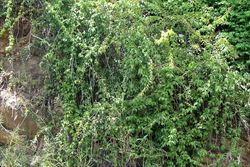
infestation (Photo: Sheldon Navie)

climbing habit (Photo: Sheldon Navie)
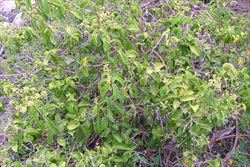
shrubby habit (Photo: Sheldon Navie)

woody stem with clusters of large spines (Photo: Sheldon Navie)
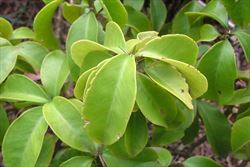
fleshy leaves and smaller spines (Photo: Sheldon Navie)
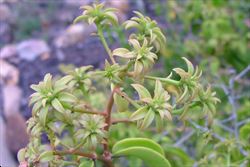
flower buds (Photo: Sheldon Navie)

close-up of flower buds (Photo: Sheldon Navie)

flowers (Photo: Sheldon Navie)

immature fruit (Photo: Sheldon Navie)
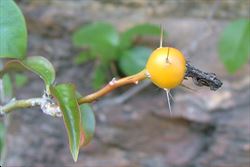
close-up of mature fruit with some spines (Photo: Sheldon Navie)
Scientific Name
Pereskia aculeata Mill.
Family
Cactaceae
Common Names
Barbados gooseberry, Barbados shrub, blade apple, blade apple cactus, leaf cactus, leafy cactus, lemon vine, lemonvine, pereskia, pereskia creeper, primitive cactus, rose cactus, Spanish gooseberry, Surinam gooseberry
Origin
Native to Central America (i.e. Panama), the Caribbean and South America (i.e. French Guiana, Guyana, Surinam, Venezuela, Brazil, Colombia, Argentina and Paraguay).
Cultivation
Occasionally cultivated as a garden ornamental in Australia.
Naturalised Distribution
Occasionally naturalised in the coastal districts of eastern Australia (i.e. in south-eastern and northern Queensland and the coastal districts of northern and central New South Wales).
Also naturalised overseas in southern Africa, Mexico and southern USA (i.e. Texas and Florida).
Habitat
A potential weed of riparian areas, urban bushland, open woodlands, dry forests, rocky areas and coastal environs in tropical, sub-tropical and warmer temperate regions.
Habit
A woody shrub or a vine wih climbing or scrambling stems up to 10 m or more long.
Stems and Leaves
It older stems are woody and bear clusters of straight spines 1-5 cm long. Younger stems are fleshy in nature (i.e. succulent) and hairless (i.e. glabrous). They bear one to three smaller spines (3-5 mm long) in the leaf forks (i.e. axils).
The alternately arranged leaves are often clustered towards the tips of the branches. They are somewhat fleshy (i.e. succulent) and are borne on short stalks (i.e. petiols) 3-7 mm long. These leaves (4-7 cm long and 2-4 cm wide) are oval (i.e. elliptic) or egg-shaped in outline (i.e. obovate) with entire margins and pointed tips (i.e. acute apices). They are often pale green in colour, especially when growing in a suny position, and are smooth and hairless (i.e. glabrous).
Flowers and Fruit
The white or yellowish flowers (25-40 mm across) are borne in clusters in the leaf forks or at the tips of the branches (i.e. in axillary ot terminal panicles). The flowers have several leafy projections, and often also some small spines, on their ovaries, which can be easily mistaken for sepals. They have several white or pale yellow 'petals' (i.e. perianth segments or tepals) that sometimes turn pale pinkish in colour as they age. Each flower also has numerous stamens that are shorter than the 'petals'. Flowering occurs mostly during summer.
The rounded fleshy fruit (15-45 mm across) turn from green to yellow and then eventually orange in colour as they mature. They eventually lose their leafy projections, and sometimes also their spines. These fruit contain several black seeds.
Reproduction and Dispersal
This species reproduces by seed and also vegetatively via its fleshy stems.
Seeds are most commonly dispersed by birds, and possibly also other animals, that eat the fleshy fruit. Seeds and stem segments may also be spread during floods and in dumped garden waste.
Environmental Impact
Leaf cactus (Pereskia aculeata) is on the Alert List for Environmental Weeds, a list of 28 invasive plants that have the potential to threaten biodiversity and cause other environmental damage in Australia. It is regarded as a potentially serious invasive weed in the coastal areas of southern Queensland and north-eastern New South Wales, where it has a tendency to form large impenetrable clumps of vegetation. It is also a potential environmental weed or "sleeper weed" in other parts of Australia.
Similar Species
Leaf cactus (Pereskia aculeata) is similar to rose cactus (Pereskia grandiflora), however the latter species can be distinguished by its more shrubby habit and bright pink flowers.

